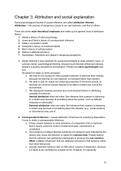Chapter 3: Attribution and social explanation
Social psychological theories of causal inference are called attribution theories.
Attribution = the process of assigning a cause to our own behavior, and that of others.
There are seven main theoretical emphases that make up the general body of attribution
theory:
1. Heider’s theory of naive psychology
2. Jones and Davis’s theory of correspondent inference
3. Kelley’s covariation model
4. Schachter’s theory of emotional lability
5. Bem’s theory of self-perception
6. Weiner’s attributional theory
7. Deschamps, Hewstone and Jaspar’s intergroup perspective
1. Heider believed it was important for social psychologists to study people’s naive, or
common sense, psychological theories, because such theories influenced ordinary
people’s everyday perceptions and behavior. People are naive psychologist (see
p.6)
He based his ideas on three principles:
a. We look for the causes for other people’s behavior to discover their motives,
because we feel that our own behavior is motivated rather than random.
b. We tend to look for stable and enduring properties of the world around us,
because we construct causal theories to be able to predict and control the
environment.
c. We distinguish between personal and environmental factors in attributing
causality for behavior.
Internal attribution when we make “the inference that a person is behaving
in a certain way because of something about the person, such as attitude,
character or personality”.
External attribution when we make “the inference that a person is behaving
a certain way because of something about the situation (e.g., social pressure
or coincidence) they are in”.
2. Correspondent inference = causal attribution of behavior to underlying dispositions.
5 cues to make a correspondent inference:
a. Freely chosen behavior is more indicative of a disposition than is behavior
that is clearly under the control of external threats, inducements or
constraints.
b. The tendency to believe that the outcomes of a behavior were intended by the
person who chose the behavior is called the outcome bias. People believe
that this behavior was performed intentionally to produce the non-common
effect (=effects of behavior that are relatively exclusive to that behavior rather
than other behaviors)
c. Socially desirable behavior tells us little about a person’s disposition, because
it is likely to be controlled by societal norms. However, it is generally
15
, counter-normative and thus a better basis for making a correspondent
inference.
d. We make more confident correspondent inferences about other’s hedonic
relevance (=refers to behavior that has important direct consequences for
ourselves.)
e. We make more confident correspondent inferences about behavior that is
high in personalism. Personalism = behavior that appears to be directly
intended to benefit or harm oneself rather than others.
3. Covariation model = kelley’s theory of causal attribution; people assign the cause of
behavior to the factor that covaries most closely with the behavior.
To make the decision whether to attribute behavior to internal dispositions or external
environmental factors, people assess three classes of info associated with the
co-occurence of a certain action by a specific person with a potential cause.
a. Consistency information = information about the extent to which a behavior
Y always co-occurs with a stimulus X.
b. Distinctiveness information = information about whether a person’s
reaction occurs only with one stimulus or is a common reaction to many
stimuli.
c. Consensus information = information about the extent to which other people
react in the same way to a stimulus X.
Where consistency is low, people discount the potential cause and search for an
alternative. Where consistency is high and distinctiveness and consensus are also
high, one can make an external attribution. Where distinctiveness and consensus are
low, one can make an internal attribution.
Causal schemata = experience-based beliefs about how certain types of causes
interact to produce an effect.
4. Emotions have two distinct components: an undifferentiated state of physiological
arousal & cognitions that label the arousal and determine which emotion is
experienced.
5. Self-perception theory = Bem’s idea that we gain knowledge of ourselves only by
making self-attributions: for example, we infer our own attitudes from our own
behavior.
6. Another extension of attribution theory focuses on the causes and consequences of
the attribution people make for how well they and others perform on a task. In making
achievement attribution, we consider 3 performance dimensions:
a. Locus, is the performance caused by the actor or by the situation?
b. Stability, is the internal or external cause a stable or unstable one?
c. Controllability, to what extent is future task performance under the actor’s
control?
According to Weiner, people first determine whether someone has succeeded or
failed and accordingly experienced positive or negative emotion. They then make a
causal attribution for the performance, which produces more specific emotions and
expectations that influence future performance.
16






